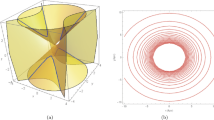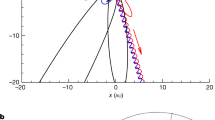Abstract
We used a multipolar code to create, through the dissipationless collapses of systems of 1,000,000 particles, three self-consistent triaxial stellar systems with axial ratios corresponding to those of E4, E5 and E6 galaxies. The E5 and E6 models have small, but significant, rotational velocities although their total angular momenta are zero, that is, they exhibit figure rotation; the rotational velocity decreases with decreasing flattening of the models and for the E4 model it is essentially zero. Except for minor changes, probably caused by unavoidable relaxation effects, the systems are highly stable. The potential of each system was subsequently approximated with interpolating formulae yielding smooth potentials, stationary for the non-rotating model and stationary in the rotating frame for the rotating ones. The Lyapunov exponents could then be computed for randomly selected samples of the bodies that make up the different systems, allowing the recognition of regular and partially and fully chaotic orbits. Finally, the regular orbits were Fourier analyzed and classified using their locations on the frequency map. As it could be expected, the percentages of chaotic orbits increase with the flattening of the system. As one goes from E6 through E4, the fraction of partially chaotic orbits relative to that of fully chaotic ones increases, with the former surpassing the latter in model E4; the likely cause of this behavior is that triaxiality diminishes from E6 through E4, the latter system being almost axially symmetric. We especulate that some of the partially chaotic orbits may obey a global integral akin to the long axis component of angular momentum. Our results show that is perfectly possible to have highly stable triaxial models with large fractions of chaotic orbits, but such systems cannot have constant axial ratios from center to border: a slightly flattened reservoir of highly chaotic orbits seems to be mandatory for those systems.
Similar content being viewed by others
References
Aguilar L.A. and Merritt D. (1990). The structure and dynamics of galaxies formed by cold dissipationless collapse. Astrophys. J. 354: 33–51
Athanassoula E. (2003). What determines the strength and the slowdown rate of bars. Mon. Not. Royal Astron. Soc. 341(4): 1179–1198
Binney J. and Spergel D. (1982). Spectral stellar dynamics. Astrophys. J. 252: 308–321
Carpintero D.D. and Wachlin F.C. (2006). Sensitivity of the orbital content of a model stellar system to the potential approximation used to describe it. Celest. Mech. Dynam. Astron. 96(2): 129–136
Contopoulos, G.: Order and Chaos in Dynamical Astronomy. Springer-Verlag
Cruz F., Aguilar L.A. and Carpintero D.D. (2002). A new method to find the potential center of N-body systems. Rev. Mexicana Astron. Astrof. 38: 225–231
Forbes D.A. and Ponman T.J. (1999). On the relationship between age and dynamics in elliptical galaxies. Mon. Not. Royal Astron. Soc. 309: 623–628
Hernquist L. and Barnes J. (1990). Are some N-body algorithms intrinsically less collisional than others?. Astrophys. J. 349: 562–569
Holley-Bockelmann K., Mihos J.C., Sigurdsson S. and Hernquist L. (2001). Models of Cuspy triaxial galaxies. Astrophys. J. 549: 862–870
Jesseit R., Naab T. and Burkert A. (2005). Orbital structure of collisionless merger remnants: on the origin of photometric and kinematic properties of elliptical and S0 galaxies. Mon. Not. Royal Astron. Soc. 360: 1185–1200
Kalapotharakos C. and Voglis N. (2005). Global dynamics in self-consistent models of elliptical galaxies. Celest. Mech. Dynam. Astron. 92(1–3): 157–188
Kandrup H.E. and Mahon M.E. (1994). Short times characterisations of stochasticity in nonintegrable galactic potentials. Astron. Astrophys. 290: 762–770
Maffione, N.P.: Comparación de indicadores de la dinámica. Tesis de Licenciatura. Facultad de Ciencias Astronómicas y Geofísicas, Universidad Nacional de La Plata (2007)
Merritt D. and Fridman T. (1996). Triaxial galaxies with cups. Astrophys. J. 460(1): 136–162
Muzzio J.C. (2003). Chaos in elliptical galaxies. Bol. Asoc. Argentina Astron. 45: 69
Muzzio J.C. (2006). Regular and chaotic orbits in a self-consistent triaxial stellar system with slow figure rotation. Celest. Mech. Dynam. Astron. 96(2): 85–97
Muzzio J.C. and Mosquera M.E. (2004). Spatial structure of regular and chaotic orbits in self-consistent models of galactic satellites. Celest. Mech. Dynam. Astron. 88(4): 379–396
Muzzio J.C., Carpintero D.D. and Wachlin F.C. (2005). Spatial structure of regular and chaotic orbits in a self- consistent triaxial stellar system. Celest. Mech. Dynam. Astron. 91(1–2): 173–190
Napolitano N.R., Capaccioli M., Romanowsky A.J., Douglas N.G., Merrifield M.R., Kuijken K., Arnaboldi M., Gerhard O. and Freeman K.C. (2005). Mass-to-light ratio gradients in early-type galaxy haloes. Mon. Not. Royal Astron. Soc. 357: 691–706
Schwarzschild M. (1979). A numerical model for a triaxal stellar system in dynamical equilibrium. Astrophys. J. 232: 236–247
Schwarzschild M. (1993). Self-consistent models for galactic halos. Astrophys. J. 409: 563–577
Šidlichovský M. and Nesvorný D. (1997). Frequency modified Fourier transform and its application to asteroids. Celest. Mech. Dynam. Astron. 65: 137–148
Sparke L.S. and Sellwood J.A. (1987). Dissection of an N-body bar. Mon. Not. Royal Astron. Soc. 225: 653–675
Statler T.S., Emsellem E., Peletier R.F., Bacon and R. (2004). Long-lived triaxiality in the dynamically old elliptical galaxy NGC 4365: a limit on chaos and black hole mass. Mon. Not. Royal Astron. Soc. 353: 1–14
Udry S. and Pfenniger D. (1988). Stochasticity in elliptical galaxies. Astron. Astroph. 198(1–2): 135–149
Voglis N., Kalapotharakos C. and Stavropoulos I. (2002). Mass components in ordered and in chaotic motion in galactic N-body models. Mon. Not. Royal Astron. Soc. 337(2): 619–630
Voglis N., Stavropoulos I. and Kalapotharakos C. (2006). Chaotic motion and spiral structure in self-consistent models of rotating galaxies. Mon. Not. Royal Astron. Soc. 372(2): 901–922
White S.D.M. (1983). Simulations of sinking satellites. Astroph. J. 274: 53–61
Author information
Authors and Affiliations
Corresponding author
Rights and permissions
About this article
Cite this article
Aquilano, R.O., Muzzio, J.C., Navone, H.D. et al. Orbital structure of self-consistent triaxial stellar systems. Celestial Mech Dyn Astr 99, 307–324 (2007). https://doi.org/10.1007/s10569-007-9104-7
Received:
Revised:
Accepted:
Published:
Issue Date:
DOI: https://doi.org/10.1007/s10569-007-9104-7




